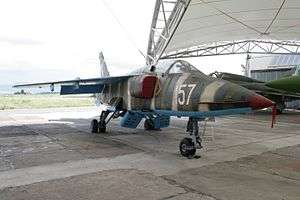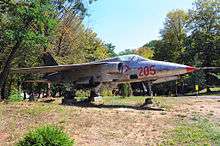IAR-93 Vultur
The Avioane Craiova IAR-93 Vultur (Vulture) is a twinjet, subsonic, close support, ground attack and tactical reconnaissance aircraft with secondary capability as low level interceptor. Built as single-seat main attack version or combat capable two-seat version for advanced flying and weapon training, it was developed as a joint Yugoslav-Romanian project in the 1970s for the air forces of both nations. The Romanian aircraft were built by I.R.Av. Craiova as IAR-93, and its Yugoslav counterpart by Soko as the Soko J-22 Orao. For Romania, the IAR-93 was intended to replace MiG-15s and MiG-17s in the fighter-bomber role.
| IAR-93 Vultur | |
|---|---|
 | |
| IAR-93 | |
| Role | Ground attack aircraft Low level interceptor |
| Manufacturer | Avioane Craiova |
| Design group | INCAS Romania VTI Yugoslavia |
| First flight | October 31, 1974 |
| Introduction | 1975 |
| Retired | April 9, 1998 |
| Primary user | Romanian Air Force |
| Produced | 1975–1992 |
| Number built | 88 |
| Variants | Soko J-22 Orao |
Development
On May 20, 1971, Romania and Yugoslavia signed the governmental agreements for the YuRom R&D programme. The program managers were Dipl. Dr. Engineer Teodor Zamfirescu for the Romanian party and Colonel Vidoje Knežević for the Yugoslav party.
The requirements called for a light subsonic aircraft for ground attack and tactical reconnaissance missions and with low level air combat as a secondary capability. It was to be built on a simple structure, using locally produced equipment and avionics (but compatible with western components), tough (able to operate on grass or damaged runways), easy to maintain and reliable. The aircraft was of conventional twin-engine, high mounted wing monoplane configuration with all flying surfaces swept. The Rolls-Royce Viper was chosen as the powerplant, as SOKO had experience with licence-building this engine. It was originally intended that an afterburner would be developed for the Viper engines, but there were prolonged difficulties with this project, meaning that none of the pre-production aircraft featured it, and neither did early production examples. During the 1980s, both countries developed slightly different versions to take advantage of the afterburning engines that had since become available.
Flight testing
The Romanian single-seat prototype White 001 made its first flight which lasted 21 minutes on October 31, 1974 at Bacău[1] (simultaneously with the Yugoslav prototype at Batajnica Air Base). The aircraft was flown by Colonel Gheorghe Stănică. On September 20, 1979 the plane was lost when, during a test flight both engines stopped and the pilot ejected. This prompted modifications to the combustion chamber (including all aircraft already delivered).
On July 18, 1975 the aircraft was presented to Nicolae Ceauşescu on the Bacău airfield.
The DC (two-seat) prototype #003 first flew on January 23, 1977, and was lost on November 24, 1977 due to tail flutter. The left elevator broke off while in level flight at 500 m altitude and 1,045 km/h. The Martin-Baker Mk RU10J zero-zero ejection seats functioned well and the two test pilots ejected safely. After this event the aft fuselage structure was reinforced.
Prototype #004 crashed at Craiova Air Base on February 20, 1979 during an aerobatics demonstration. The pilot, Capt. Eng. Dobre Stan didn't manage to eject.
On August 23, 1979 three IAR-93 (#001, #002 and #005) were first presented to the public in flight during the military parade celebrating the national day of Romania at that time.
Variants
- IAR-93A: initial production version with non-afterburning Viper Mk 632-41 turbojets
15 pre-production aircraft delivered in 1979; entered service in 1981
26 built (#109-119 pre-production, #150-164 series) as single-seaters and 9 DC (two-seat) trainers (#005-008 pre-production, #180-184 series) - IAR-93MB: MB = Motor de Baza (basic engine). This version had the fuselage of the IAR-93B but used the non-afterburning engine of the IAR-93A
delivered starting with 1982
15 single-seaters built (#201-215) - IAR-93B: refined version with afterburning Viper Mk 633-47 engines, increased internal fuel capacity, upgraded hardpoints and revised wing, including leading edge extensions. Also, the ventral fins, inboard wing fences and forward fuselage strakes were removed
first flew in 1985; entered service in 1987
27 built as single-seater (#200, #216-241) and 7 DC (#600-606)
Operators
- Romania
- Romanian Air Force (67th Fighter-Bomber Regiment and 49th Fighter-Bomber Regiment from Craiova and Ianca respectively)
Lost aircraft
Data from Romanian press and partially from ejection-history.org.uk[2]
- #003, November 24, 1977 The left elevator broke off due to flutter. Both pilots, Col. Gheorghe D. Stanica and Col. Petru Ailiesei, ejected safely.
- #004, February 20, 1979 at Craiova Air Base. Crashed during an aerobatics demonstration. Capt. Eng. Dobre Stan, didn't manage to eject.
- #001, September 20, 1979 Both engines stopped. Col. Ilie P. Botea ejected safely.
- #113, March 8, 1983 Maj. Crashed on landing due to pilot error. Maj Ion G. Tanase ejected safely.
- #???, August 14, 1986 G.M. Stoica (not confirmed or incomplete info)
- #602, August 25, 1992 Both pilots, Maj. Dan C. Cosaceanu and Cpt. Traian G. Neagoe, ejected safely.
- #200, November 26, 1996 at Recea-Slatina. Crashed during a test flight. Cpt. Cmdr. Matei "Bebe" Constantin ejected safely.
- #210, July 9, 1997 at Craiova Air Base. Exploded on the runway during preparations for Romanian-made cluster munitions testing. 16 ground personnel died. The pilot, Cmdr. Ion Marculescu, hadn't yet approached the plane and was unharmed.
- #219, April 9, 1998 at Ghercesti, near Craiova. The forward landing gear could not be deployed after a test flight. Cmdr. Ion Marculescu ejected safely after exhausting the fuel and the airplane crashed a few km further. This was the last flight for the type.
Retirement
Following the outbreak of the war in Yugoslavia and the UN embargo, the IAR-93 program ended in Romania in 1992, with several airframes in different stages of construction. Around 75 aircraft were still in service, a few of them being used for testing and research (#200 – first B model with afterburners, #600 (DC) – the only one fitted with canards).
The last IAR-93s were withdrawn and mothballed from the Romanian Air Force in 1998. Surviving airframes are stored at Deveselu (IAR-93A #116), Timișoara (IAR-93MB #214), and Craiova (about 60 aircraft), not flight worthy (engines and other equipment removed) and most of them are up for sale. Apparently 20 of them were scrapped until 2006, with the rest awaiting the same fate in 2007.
The J-22 Orao are still in service with the air force of Serbia. The last Yugoslav aircraft was delivered in February 1992, and the plant in Mostar was destroyed shortly after.
Aircraft on display

- #002 (prototype DC) Aviation Museum, Bucharest (44°28'39.7"N 26°06'41.8"E)
- #109 (A) Henri Coandă School courtyard, Perisor, Dolj
- #112 (A) Aviation Museum, Bucharest (44°28'39.8"N 26°06'42.2"E)
- #114 (A) Aviation Museum, Bucharest (44°28'38.9"N 26°06'40.9"E)
- #153 (A) at the National Military Museum, Bucharest (44°26'25.3"N 26°04'36.4"E)
- #157 (A) donated by the Romanian Air Force to the Museum of Aviation in Košice, Slovakia on October 23, 2006
- #159 (A) in Bucharest, at the gate of I.N.C.A.S./Comoti Institut (the birthplace of IAR 93 and IAR 99) (44°26'03.5"N 26°00'21.3"E)
- #182 (A) Aviation Museum, Bucharest (44°28'38.5"N 26°06'39.7"E)
- #201 (MB) in Timișoara, on the road to Resita (45°43'8.27"N; 21°11'58.77"E)
- #205 (MB) in Orăștie, at Arsenal Park (45°50'02.7"N 23°09'52.7"E)
- #206 (MB) in Pivka Military History Park, Pivka, Slovenia
- #207 (MB) in Timișoara (45°44'4.65"N; 21°15'49.65"E)
- #208 (MB) Faur factory courtyard, Bucharest (44°25'38.7"N 26°10'49.3"E)
- #215 (MB) Colonesti, Olt (44°38'01.3"N 24°40'41.2"E)
- #216 (MB) Bălăbănești, Galați (46°05'22.1"N 27°43'04.6"E)
- #232 (B) in the Military Technical Academy's courtyard, Bucharest
- #600 (DC) in the Air Force Academy's courtyard, Braşov
Specifications (IAR-93B)
Data from Avioane Craiova SA,[1] INCAS - IAR 93 SOKO /VTJ - J - ORAO[3]
General characteristics
- Crew: 1
- Length: 14.9 m (48 ft 11 in) single-seat
- 15.38 m (50 ft) two-seats
- Wingspan: 9.3 m (30 ft 6 in)
- Height: 4.52 m (14 ft 10 in)
- Wing area: 26 m2 (280 sq ft)
- Aspect ratio: 3.33
- Airfoil: NACA 65A-008 mod.[4]
- Empty weight: 5,750 kg (12,677 lb)
- Gross weight: 8,400 kg (18,519 lb)
- Max takeoff weight: 10,900 kg (24,030 lb)
- Maximum landing weight: 9,360 kg (20,635 lb)
- Fuel capacity: 2,400 kg (5,291 lb)
- Powerplant: 2 × Turbomecanica/Orao-built Rolls-Royce Viper Mk 633-47 afterburning turbojet engines, 17.79 kN (4,000 lbf) thrust each dry, 22.24 kN (5,000 lbf) with afterburner
Performance
- Maximum speed: 1,086 km/h (675 mph, 586 kn) at sea level
- Maximum speed: Mach 0.9
- Cruise speed: 1,087 km/h (675 mph, 587 kn) / M0.88 at 5,000 m (16,404 ft)
- Stall speed: 274 km/h (170 mph, 148 kn)
- Combat range: 260 km (160 mi, 140 nmi) lo-lo-lo with four rocket launchers, 5 min over target
- 380 km (240 mi; 210 nmi) hi-hi-hi patrol with three 500 litre drop tanks, 45 min over target
- 450 km (280 mi; 240 nmi) lo-lo-hi with two rocket launchers, six 100 kg bombs and one 500 litre drop tank, 10 min over target
- 530 km (330 mi; 290 nmi) hi-hi-hi with four 250 kg bombs and one 500 litre drop tank, 5 min over target
- Service ceiling: 13,600 m (44,600 ft)
- g limits: +8 -4.2
- Rate of climb: 65 m/s (12,800 ft/min)
- Wing loading: 419.2 kg/m2 (85.9 lb/sq ft)
- Thrust/weight: 0.417
- Take-off run: 800 m (2,625 ft)
- Take-off run to 15 m (49 ft): 1,150 m (3,773 ft)
- Landing run: 1,050 m (3,445 ft)
- 690 m (2,264 ft) with brake parachute
- Landing run from 15 m (49 ft): 1,520 m (4,987 ft)
- 1,520 m (4,987 ft) with brake parachute
Armament
- Guns: 2 × 23 mm Gryazev-Shipunov GSh-23 autocannons in lower front fuselage, below engine air intakes, with 200 rounds per gun; gun camera and GEC-Marconi D282 gyro gunsight installed
- Hardpoints: up to 2,500 kg (5,511 lb) on 5 pylons
- Rockets:
- LPR 122
- LPR 57
- PRN 80
- Missiles:
- Bombs:
- BM 500 general-purpose bomb
- BEM 250
- BE 100
- BL755 cluster bomb
Avionics
- VHF/UHF air-to-air and air-to-ground radio (20W transmission power)
- gyro unit (Honeywell SGP500 twin-gyro platform in ORAO)
- radio altimeter
- ADF
- radio compass and marker receiver
- IFF (IAR-93B only)
- GEC-Marconi three-axis stability augmentation system, incorporating a basic bank/altitude hold autopilot and emergency wings-level facility
See also
Related development
Aircraft of comparable role, configuration and era
- AMX
- Mikoyan MiG-27
- Mitsubishi F-1
- SEPECAT Jaguar
- Xian JH-7
References
- "IAR-93 History". Archived from the original on 2012-02-27. Retrieved 2009-09-28.
- "Chronological Listing of Romanian Losses & Ejections". Archived from the original on 2009-01-05. Retrieved 2009-12-17.
- "INCAS - IAR 93 SOKO /VTJ - J - ORAO". www.incas.ro. Retrieved 7 October 2019.
- Lednicer, David. "The Incomplete Guide to Airfoil Usage". m-selig.ae.illinois.edu. Retrieved 16 April 2019.
External links
| Wikimedia Commons has media related to IAR 93. |
- National Institute for Aerospace Research "Elie Carafoli"
- Photos of IAR-93 at Airliners.net
- More photos at aeroflight.co.uk
- Retired aircraft at 322 Aviation Maintenance Centre, Craiova
- Movie at YouTube